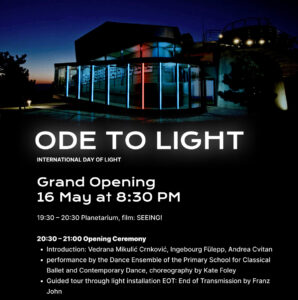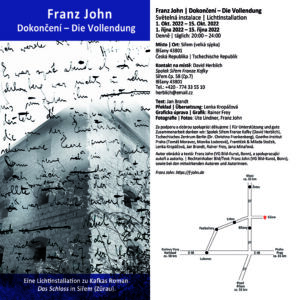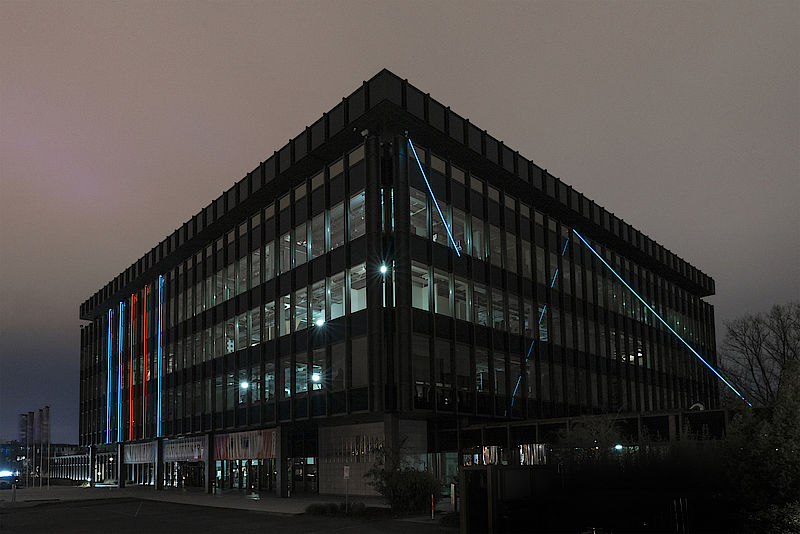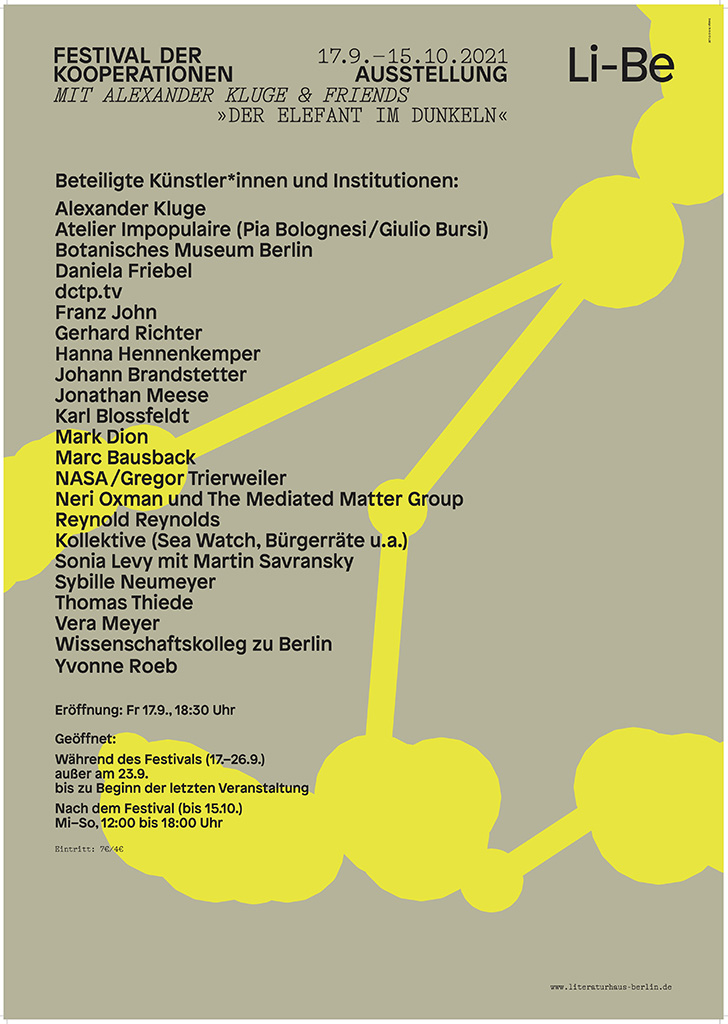2023 / 2024 / 2025 …
Franz John – EOT : End of Transmission
Light installation for the UNESCO International Day of Light
Astronomy Center Rijeka, Croatia
Opening: May 16, 2025 at 8:30pm
May 16th – May 18th 2025, daily 8pm – 12pm
-> videoclip (7min)

Franz John: The Alley Window
Goethe-Institute Prague, ČR
Oct. 10, 2024 – Oct. 24, 2024
-> extended until Oct. 31, 2024
Light installation, daily 6pm – 12pm

“People are connected to each other by invisible threads,” wrote Franz Kafka in a letter to his friend Oskar Pollak in 1903. German artist Franz John’s light installation at the Goethe-Institute building in Prague works with Franz Kafka’s texts and combines his metaphors with the Art Nouveau style of the building.
Organized by: Goethe-Institute Czech Republic as part of Kafka2024
Project and title “The Alley Window” refers to Franz Kafka’s early prose sketch Das Gassenfenster, c. 1910.
Dark Star
Atelier Grammophon – Alte Grammophonfabrik
Nov. 10, 2023 – Nov. 26, 2023
Hanover, Germany
The exhibition Dark Star featured artistic statements and positions that deal with issues of gravity and astronomy in a broader sense. Conception: Franz John in cooperation with Dr. Benjamin Knispel (AEI).
Participating artists:
• Hannah Schneider „Orbit“
• Jörg Hufschmidt „Mikrokosmos“
• Franz John „Beyond the Zero“
• Ulrike Schoeller „Kleine Passage 2.7 Fuß“
• Helga Franz „Schwindlige Pflanzen“
• Sergio Prego „Tetsuo Bound to Fail“
• RaumZeitPiraten „Drafts for Zero Gravity“
The exhibition was embedded in the event framework of the Albert Einstein Institute Hanover for the November of Sciences 2023. It followed a colloquium with a panel discussion at the Max Planck Institute for Gravitational Physics (Albert Einstein Institute).
>> Link to the event
Dokončení – The Completion
October 01, 2022 – October 15, 2022
Siřem, Czech Republic

Dokončení – The Completion
A light installation by Franz John on Franz Kafka – The Castle
Siřem (Zürau), Czech Republic
„It was late in the evening when K. arrived. The village was deep in snow. The Castle hill was hidden, veiled in mist and darkness, nor was there even a glimmer of light to show that a castle was there. On the wooden bridge leading from the main road to the village K. stood for a long time gazing into the illusory emptiness above him.“
This is how Franz Kafka’s last unfinished novel “The Castle” begins, in which a man comes to a village as a Land Surveyor, but will never do this activity. Although Franz Kafka began the text in the winter of 1922 in the climatic health resort of Spindlermühle (and broke off in the middle of the sentence in the late summer of the same year), the characterization of the place bears clear features of Siřem (former Zürau), where he stayed five years earlier after his hemorrhage. There was no castle in Zürau, but there was a large storehouse, which still towers over the village like a castle.
The Berlin artist Franz John makes sites itself to the protagonist of his works. He gets involved with the respective history and brings the memory stored in back to light. As in his recent works in the old tobacco factory in Schwedt or in the Heinz Nixdorf Museum in Paderborn, he also gives shape to the invisible rays of our imagination with the help of light wires in Dokončení – The Completion. He brings light into the darkness and breathes new life into the empty storage building in Siřem. In doing so, he picks up the lines of force of the building and extends them outside, into the open.
They are lights that point to a goal, but end up in nothingness, as in Kafka’s novel.The blue light wires appear like laser beams. They visualize communication attempts from a secret command center, messages that go nowhere and yet are so attractive that once you have noticed them, you can’t ignore to find out more and more about them. In this indicated movement, Franz John brings a work of world literature to an end after 100 years, which still puzzles to this day.
Text by Jan Brandt
Photo overview of the opening day: Oct 01, 2022
Franz John: Viva Maria
einszueins – Kunst in der Køniglichen Backstube
Berlin-Neukölln, Germany
May 14, 2022 – Aug 13, 2022
In the store premises to the right of today’s bakery, an illegal printshop was operated that produced leaflets, posters and publications of the “revolutionary movement” associated with the student movement that radicalised after 1967. Franz John now makes the history of the place comprehensible: A confidential report by the political police from April 1967 documents investigations at Zwiestädter Straße 10 and observations by some inspector Böhme. This archival document, which takes up the entire exhibition wall, is accompanied by a listening station. Here you can hear a talk with Ulrich Enzensberger, once a founding member of Kommune I, who knew the illegal printshop and the activities of the time well. This conversation, conducted by Franz John, provides insights and interesting details about the history of the sight and Berlin contemporary history in late 1960s. Text by Martin Steffens
Talk with Ulrich Enzensberger, Writer, and Franz John on June 25th at 5pm.
einzueins – Kunst in der Køniglichen Backstube is a project by Kati Gausmann. Viva Maria – Cult film of the ’68 movement by Louis Malle.
Franz John: 11001 – End of Medium
Light Installation at Heinz Nixdorf MuseumsForum.
Dec 10, 2021 – Jan 09, 2022
Paderborn, Germany
https://www.hnf.de/ausstellungen/11001-end-of-medium.html

Photo: Reinhardt A. Hardtke / HNF

– Festivallink: https://literaturhaus-berlin.de/mediathek
– Contribution: Franz John – Turing Tables
Listening to the hops grow …
.
.
This project started with a first installation and intervention during the COVID-19 lockdown at the Würzburg Residence (Nov. 29th, 2020) and the cultivation of several hops varieties in Berlin in spring 2020 to test different sound qualities.
Franz John engages in new and old media, which he uses to investigate the boundaries between human and machinic possibilities of perception and representation in relation to natural phenomena. In his works he combines intensive research and scientific analysis with vivid and often touchable and usable installations in public space. Often he deals with site-specific art projects that resonate with the historical, geological or climatic characteristics of a region.
During a one year scholarship in Friedrichshafen in 2019, Franz John continued working on his project Color as Resource. For this project, the artist produced pigment solar cells from plants that are typical for the region. He uses these so-called Graetzel Cells as energy sources for his sound and light installations. For this purpose, he has, for the first time, produced such pigment solar cells from hops, an old regional crop. In the meantime, he has expanded his artistic-scientific sensorium – not least inspired by the sudden silence during the first lockdown in the COVID-19 pandemic – by adding a sound component that lent his research activity something of a meditative dimension. Since then he has been listening closely to the hops, one of the fastest growing plants besides bamboo (up to 30 cm per day in summer).
Text by Clemens Krümmel
![]() The project “Listening to the hops grow …” was made possible by a grant from NEUSTART KULTUR, special funding program 2020/21 of the Stiftung Kunstfonds, Bonn, Germany.
The project “Listening to the hops grow …” was made possible by a grant from NEUSTART KULTUR, special funding program 2020/21 of the Stiftung Kunstfonds, Bonn, Germany.
![]()